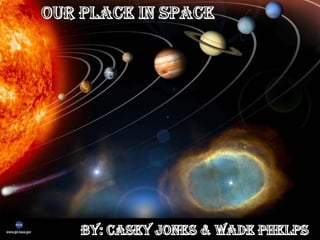
Solar System
- 2. -Stretches approximately 100,000 light years in diameter. -Spiral Formation Galaxy. -Super-massive black hole in center of galaxy known as Sagittarius A*. -Our solar system is located approximately 26,000 light years from Sgt A*. -In the time it takes you to finish this sentence, you will have been carried along by the sun and the earth through 750 miles of actual raw space.
- 3. -Period of revolution around galaxy: 220 million years. -Equatorial rotation period: 25 days. -Our Sun (also known as Sol) has sunspot regions on it’s visible layer during a 11 year cycle which helps us determine the Sun’s solar cycle and rotation period. -The hottest layer of the Sun, known as the corona, typically reaches temperatures in the range of 1 million Kelvin. That’s 1,799,540° F! Recommendations: SPF 1 million.
- 4. -Closest to the Sun. -Period of revolution: 88 days. -Large iron core. -Temperature: 700 Kelvin by day/ 100 Kelvin by night. -Before 2008, scientists had observed only 40% of the Mercury has been thought to have planets surface. collided with a massive asteroid big enough to leave a hilly terrain on the opposite side of the impact. Unknown terrain
- 5. -Known as the “Morning Star”. -Period of revolution: 225 days. -Temperature: 750 Kelvin. -Venus is covered with gently rolling hills, two continents, and numerous volcanoes. -Venus is hotter than Mercury because it is covered with huge sulfur clouds that cause an out of control greenhouse effect on it’s -Scientists suggest that Venus was hit by surface. an asteroid roughly the size of the planet which caused Venus to slowly rotate -On Venus it rains sulfuric acid!! clockwise rather than counter-clockwise like the rest of our solar system.
- 6. -Period of revolution: 365 days. -Only known planet to inhabit life. -Tilted 24° from it’s axis. -Water covers 71% of earth’s surface. -Sidereal period of revolution: 27 days. -First landing on moon: July 20th 1969. -Our moon is in synchronous rotation which causes us to see only one side of the moon.
- 7. -Period of rotation: 687 days. - 95% of atmosphere is composed of carbon-dioxide. -Has the largest known volcano called Olympus Mons. 3x the size of Mt. Everest. -Surface features indicate that water once flowed on Mars. Valles Marineris: Enormous canyon that stretches the length of the U.S. Phobos and Deimos: Planetesimals captured by the gravitational pull of Mars.
- 8. Mars Jupiter -Between the orbits of Mars and Jupiter are -Asteroids are composed primarily believed to be millions of such bodies, called of metal and rock. The largest asteroids which form a giant ring called the asteroid, Ceres, has a diameter of asteroid belt. about 900km.
- 9. -Io: Snows sulfuric acid on surface. -Europa: Icy surface which suggests water inside the moon. Great Red Spot!! -Ganymede: The largest -Period of rotation: 12 years. moon in the solar system. -Jupiter’s clouds are in perpetual motion and are confined to narrow bands of -Callisto: Appears to be rising and falling gases. homogeneous (no iron core). -Rotates once every 10 hours (the fastest of the planets).
- 10. -Period of revolution: 30 years. -Saturn’s spectacular rings are composed of fragments of ice and F Ring: Gap between rock from moons and rings created by the asteroids that have Shepherd moons. come too close to Saturn's Roche limit. -Scientists discovered a storm -Saturn has two on Saturn in 1994. Located near moons known as the it’s equator, it stretches 12,700 Shepherd moons km across, making its diameter which create a gap in roughly the same as that of the Saturn’s ring system. Earth.
- 11. -Period of revolution: 84 years. -Magnetic field is 50 times stronger than that of the Earth. -Uranus remarkably is tilted 59° from its axis of rotation causing it to rotate almost -Uranus also has its own ring completely sideways. system similar to Saturn. They were discovered by accident in -The moons of Uranus also 1977 when the planet passed in rotate sideways on the front of a star. The star’s light was planets axis, making it quite momentarily blocked by each a unique sight. ring, thereby revealing their existence to astronomers.
- 12. -Period of revolution: 165 years. -The winds on Neptune blow as fast as 2000 km/h among the fastest in the solar system. -The Great Dark Spot, whose diameter at the time was about the same size as the Earth’s diameter, is near the -Neptune has eight known center of this picture. It moons. Seven have irregular has since vanished. Note shapes and highly elliptical the white, wispy methane orbits, which suggest that clouds. Neptune captured them.
- 13. -Period of revolution: 249 years. -On August 24, 2006, Scientists decided that Pluto is no longer a planet because it doesn’t clean up debris outside it’s atmosphere. Three properties to define a planet: 1. Needs to be spherical. 2. Needs to revolve around a sun. 3. Needs to be able to clean up debris outside it’s atmosphere.
- 14. Most comets that eventually return to the -This belt of comets extends out some 500 inner solar system and develop the long AU from the sun. Astronomers estimate tails that we usually associate with are that the belt contains at least 200 million believed to come from a region out comets. beyond the orbit of Pluto called the Kuiper belt.